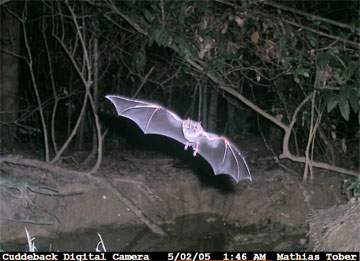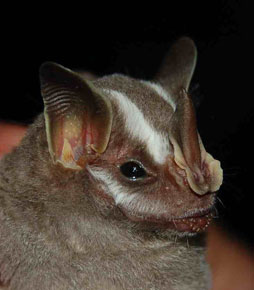Fruit bats frequent clay-licks in the Amazon rainforest
Fruit bats frequent clay-licks in the Amazon rainforest
Jeremy Hance, mongabay.com
July 14, 2008
In the Peru new research finds that female fruit bats are frequent visitors to clay-licks
|
|
Clay-licks, or collpas as they are called in Peru, are visited by a wide assortment of animals, including parrots, tapirs, peccaries, agoutis, and monkeys. But one visitor to the collpas has long been ignored by researchers: the bat. In the Peruvian Amazon, Adriana Bravo from Louisiana State University made the first comprehensive study of bats at collpas.
Using nets Bravo and her colleagues caught bats at three different collpas and three different places in the forest. They found that the collpas were a hotspot of activity for bats: ten times more bats were caught at the collpas than in the forest. Furthermore, frugivorous bat species—bats who rely almost primarily on fruit—comprised nearly the entirety of catches at the collpas, including twenty-four of the twenty-six species.
 Bat at a Los Amigos collpa in Peru. Photo by Mathias Tobler using an infrared (IR) camera trap |
Bravo and her team further discovered that 70 percent of bats at the collpas were female and three-fourths of these females were either pregnant of lactating. Bravo speculates that the collpas’ water provide essential nutrients to reproductive females that are unnecessary or superfluous for male bats.
Though a large number of mammals and birds visit collpas, scientist’s still don’t fully understand why. Some theories conclude, like Bravo’s, that the collpas is a source of extra nutrients. Others believe the collpas’ water and dirt (which is also often ingested) is consumed as a type of antacid, an antidiarrheal, or to aid in the absorption of toxins related to the animal’s diet. Of course, different species may visit the collpas for very different reasons.
 Vampyriscus bidens, a frugivorous bat species that visits collpas. Photo by Adriana Bravo |
Bravo is currently analyzing the water in the collpas. At a presentation at the ATBC conference in Paramaribo, Suriname, Bravo told her audience that preliminary results show that the water is more “basic” and has a “higher concentration of minerals” including calcium, sodium, potassium, and magnesium. The water contains a potent mix of essential vitamins, which Bravo says the female bats are able to take advantage of without a large expenditure of energy.
Since the study shows that frugivorous female bats use collpas’ water as a dietary supplement, Bravo believes the collpas deserve special conservation attention: fruit bats are one of the rainforest’s primary seed dispersers, and therefore key to health of any tropical forest.
Collpas: Activity Hotspots for Frugivorous Bats (Phyllostomidae) in the Peruvian Amazon. Adriana Bravo, Kyle E. Harms, Richard D. Stevens, and Louise H. Emmons. Biotropica, 2008.